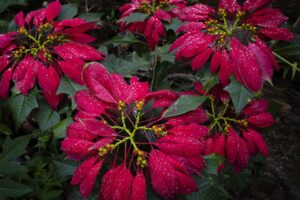How Propagated Poinsettias from Cuttings

Poinsettias are beautiful plants with colorful showy bracts or leaves that can add much flavor to any indoor or outdoor living space, and while it’s true that care must go into these garden beauties for them to maintain their beauty there are several methods that’s been used to increase their numbers which will not cause you much except for your time. Below we will be discussing such methods that have proven to give much success, so let’s take a closer look at how poinsettia plants are propagated.
Propagating Poinsettias from Cuttings
1. This method involves taking poinsettia cuttings in early summer which is the best time because this is when new growth will begin to emerge. You will need a hand pruner to take cuttings from the parent (poinsettias) plant. Ensure however that your pruner is sterilized if you have used it previously on other plants, the reason for this (sterilizing) is to avoid or discourage the spread of disease.
2. Next take 3-t0-6 inch cuttings from the tips of new growth.
3. Now dip the cut ends in root tone, root tone is a hormone that stimulates or encourages the growth of new roots, root tone comes in gel, liquid, or powdered form. If using powder then dip the cut end of the poinsettia in water and then into the root tone, the reason for this is that the moisture will help the root tone to stick to the cuttings.
4. Have several 6-inch plastic plant pots or containers with drain holes ready, each container should have a good potting mix, a good potting mix will hold nutrients and moisture but will allow excess water to drain through.
5. With your finger make a small hole in the potting mix, now the cut end of the poinsettias that were dipped in root tone place in the hole, hold the cutting upright, and firm the soil around it.
6. Place a plastic bag over each cutting, the plastic bag should be loosely secured, the reason for this is for moisture to be retained. Now place each pot in an area that gets bright indirect sunlight, direct sunlight will cause the loss of moisture and plant burn.
7. After 4 weeks or thereabout new roots should have developed, a sure sign of the growth of new roots is the emergence of new leaves, remove the plastic bag and continue to take care of your cuttings by giving them the right amount of water which entails keeping the soil somewhat moist not water saturated which will encourage root rot. Once the cuttings grow into a mature plant move the plant to a bigger pot.
How to Propagate Poinsettias from Seeds
Once the poinsettia’s seeds begin to brown remove the seeds from the pods, these seeds should be stored in a paper bag that’s tightly sealed so that the seeds can dry completely. A sign that the poinsettia’s seeds are ready to plant is when the seeds pop out of the pods.
The seeds can now be planted in 6-inch plastic pots or containers, use a good potting mix as well, plant the seeds just below the soil’s surface because planting seeds too deeply will not germinate. Now water the seeds, the soil should be slightly damp and at all times, excessive moisture will lead to root rot, the pots should be kept in a warm area that gets indirect sunlight. Avoid direct sunlight, in a few weeks seedlings, will appear, to discourage disease allow the air to circulate around each plant.
The final word on how Poinsettia Plants are Propagated
These methods of propagating poinsettias will populate your indoor and outdoor living space with these garden beauties, I believe that investing in the propagation of poinsettias is worth the effort. Give it a try, you will be so happy with the results. Once the holiday season has passed continue to care for your poinsettias along with including these propagating methods that will increase your poinsettias numbers.
About the author
Norman loves being in the garden, both at home and for his job....
he is 'Natures Little helper' being outdoors, growing his vegetables and flowers from an early age.
Now having spent over 22 years in the profession he want to give some of his knowledge to others...
his vast array of hints and tips you will find scattered over this site will help you no end growing plants in your garden.
